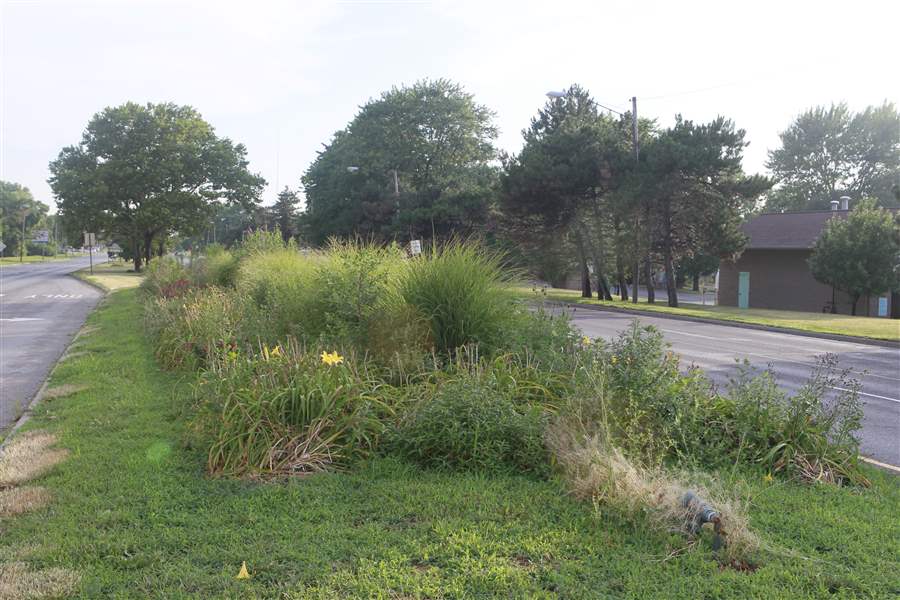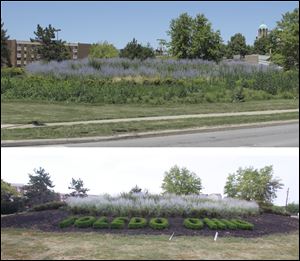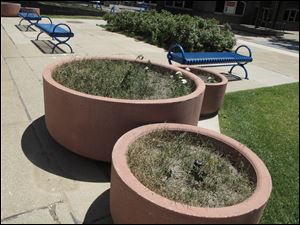
Flowers vanishing from Toledo because of wilted economy
Weeds fill once beautiful city areas
8/8/2011
Roses, butterfly bushes, day lilies, and peonies that filled the median along the Anthony Wayne Trail, gateway to the Toledo Zoo, were choked out by weeds because the city shut down its urban beautification program.
THE BLADE/JEREMY WADSWORTH
Buy This Image

Roses, butterfly bushes, day lilies, and peonies that filled the median along the Anthony Wayne Trail, gateway to the Toledo Zoo, were choked out by weeds because the city shut down its urban beautification program.
Where have all the flowers gone?
Red ink killed them, every one.
In this, the summer of floral discontent, 16 years of urban beautification that won the hearts of Toledo dwellers and praise from outsiders has largely disappeared. Roses, peonies, and day lilies have been suffocated by weeds and felled by trimmers. Large concrete planters that splashed downtown with color and softened its edges are now giant ashtrays.
Here's a delicious little irony: On a July afternoon at TARTA's Government Station at Jackson and Erie streets, two waiting buses were artistically wrapped with pastel graphics and poetic wisps about the environment. "Restore Planet Earth," they beseech.
A few feet away is a pocket of land that Planet Earth has snatched back with gusto: What had been a garden of perennials and pedigreed evergreens is choked with mulberry trees, milkweed, and thistles. A small opening in the back leads to a clearing just big enough for a person to sleep in, and it's littered with bottles and food wrappers.
If you're playing with house money, this an easy bet: Pit Team A (marigolds, geraniums, petunias that cost money, get thirsty, and require maintenance) versus Team B (bindweed, lamb's quarters, and Queen Anne's lace that ask for nothing more than a bit of soil to latch onto), and B will win every time.
Evidence abounds throughout Toledo: Weeds rule.
"You can't have a place you're embarrassed about," said downtown attorney Frank Jacobs, adding that neglect begets neglect: "It's contagious."
Mayor Michael Bell cited dire financial straits. In order to balance the 2010 budget without raising taxes, $48 million had to be cut. His priorities: police, fire, roads, and tearing down abandoned houses.
"You're going to make somebody mad somewhere," Mr. Bell said. "For people to expect the city to do all of that [landscaping], it's not going to happen."
Hundreds of concrete planters that had brightened downtown are home to whatever sprouted from seeds delivered by the Earth's first gardeners: bird and breeze. Ten planters in front of the Family Court Center on Michigan Street sport a bumper crop of cigarettus buttus. Across the street, a stretch of rose bushes that was often the backdrop for Lucas County Courthouse wedding photos is corrupted.

Weeds erased the name of the city at the corner of Summit and Cherry streets near the Martin Luther King, Jr., bridge in downtown Toledo, above. Since then, weeding has uncovered 'Toledo Ohio' written out in trimmed boxwoods.
A triangle near the Lucas County courthouse at Jackson and Michigan streets, once resplendent with pink roses and lavender Russian sage, was so smothered in thorns and bindweed that by late June, it seemed unsalvageable. A city crew spent a few blistering days thrashing around with whackers and pruners and filled trucks with green debris.
RELATED ARTICLE: Residents step up to help preserve city flower power
Thousands of dollars in perennials lining the Anthony Wayne Trail and planters in the Reynolds Road median, gateways for people visiting the Toledo Zoo from Detroit and Ann Arbor, were choked with weeds most of the summer, but the weeds and the flowers have been eliminated.
Also receiving the ax was a small program in the city's parks and forestry department that had a big impact: urban beautification.
In 2009, urban beautification's $400,000 budget paid for two permanent and six seasonal (nine-month) employees, the operation of a couple of trucks, fertilizer, and a few private landscapers to do some planting and irrigating. Half of that money came from the city's general fund; the other half from assessments that property owners pay in a category called "boulevards and triangles," which provides mowing and snow plowing, Denny Garvin, the city's commissioner of parks and forestry, said.
Jen Sorgenfrei, Mayor Bell's spokesman, puts the savings to the city's 2010 general fund at $119,117.
Former Mayor Carty Finkbeiner, who admits he didn't stop and smell the flowers in his own backyard until he retired, has some choice words on the subject.
"It is absolutely a case of the city being extremely short-term in their vision. There isn't a city that has a viable future as an attraction for business and industry that doesn't include a very small, modest amount of money being spent to make certain that its entry points, its parks, its boulevards, and its downtown are as clean and as green and as attractively decorated as possible," he said.
During his 12 years as mayor, Mr. Finkbeiner pushed for flowers throughout the town.
"When we brought people in from far away to do business in Toledo they'd say two things: 'How do you keep your streets so clean?' and they liked the flowers," Mr. Finkbeiner said. "This is peanuts. You've got to make your city look good even in hard times. … And it simply makes a middle-income neighborhood a much more attractive and enticing place to live."
Overwhelmed
On July 4, 2000, Mr. Finkbeiner led a picture-perfect celebration in a century-old, mixed-income neighborhood. Remembered fondly by residents, it was the dedication of Harvard Circle Fountain, a $125,000 stainless-steel sculpture of three wavy columns topped by clouds raining water. Around the fountain the city landscaped and irrigated to the tune of $98,000.
City employees planted, weeded, trimmed bushes, and restored when wayward vehicles drove across the circle until 2010, when Wall Street's 2008 economic crisis had trickled down to program cuts in Toledo.
The fountain is near Walbridge Park, and the South Toledo neighbors who serve on the park's advisory board agreed to pitch in. Last year, they purchased and planted perennials and weeded, with help from city workers.
This year, with the crisis not over, it was volunteers or nothing. A half-dozen neighbors spent about 40 hours spreading mulch and weeding the 3,100-square-foot circle, before becoming overwhelmed.
"It's a huge job to keep that garden up," Marj Mulcahy, who also tends the park's arch garden, said. "It's bigger than what the board had time to do."
With their annual July 4th celebration coming up at the fountain, they spent $1,000 of the board's funds and hired a landscaper to weed and trim. Unionized city workers took note of the landscaper. They filed a labor grievance.
What next?
"We're stuck between a rock and a hard place," said Hank Pauley, chairman of the Walbridge Park board: Either neighbors weed and trim on a regular schedule, or the circle goes down.
Veggies sprouting
HOW TO HELP
The city’s parks and forestry department invites calls from people who want to volunteer or to donate to its Urban Planting and Landscaping Grant fund.
Call the Parks and Forestry division at 419-245-3357.
Walks around downtown this summer turned up scores of weedy planters in Levis Square, Promenade Park, along Summit Street, and a veritable jungle behind the old steam plant along the Maumee River. But at the intersection of Summit and Jackson streets, there's a large vegetable patch that bears a friendly sign: "Welcome to United Way's Community Garden. Pick a Weed, Take a Veggie." By late June, red lettuce was leafed out; in early August, tomatoes are nearing red.
At a time when there's no money for flowers, there's money for vegetables. Urban agriculture is hot.

Weeds grow in Levis Square planters that once displayed colorful and aromatic flowers downtown.
Why are veggies in vogue?
They address health and nutrition in a nation that has forgotten how to nourish itself, notes Michael Szuberla program director of Toledo Grows. And homegrown produce saves money, adds beauty, is great recreation, and builds communities.
Can Toledo Grows assist with floral landscaping?
"We don't have the budget to do it without compensation," Mr. Szuberla said.
George Habboosh wants city politicians to get out and walk the streets to see for themselves what's going on. Across Huron Street from City Grill, the cafe he runs with his brother, Elias, are curbed beds between the sidewalk and a parking lot. Willowy, aromatic Russian sage and potentilla shrubs have lost ground to weeds, food packaging, and beverage containers.
"People need to take the time to see how the city really is," Mr. Habboosh said. "I know there are many, many organizations around Toledo that can come up with people to clean up the city."
Contact Tahree Lane at: tlane@theblade.com or 419-724-6075.